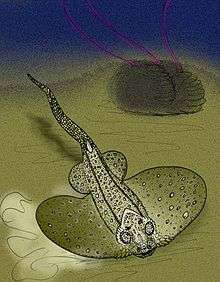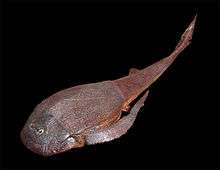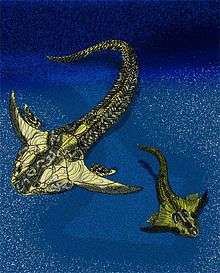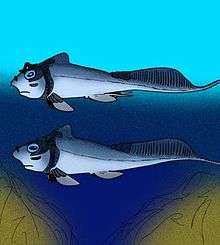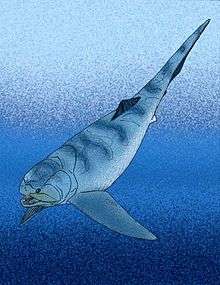Entelognathus
Entelognathus primordialis (“primordial complete jaw”) is a placoderm from the late Silurian (Ludlow epoch) of Qujing, Yunnan, 419 million years ago.[2][1]
| Entelognathus primordialis | |
|---|---|
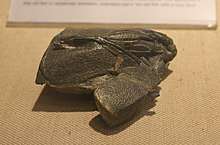 | |
| Holotype, Paleozoological Museum of China | |
| Scientific classification | |
| Kingdom: | Animalia |
| Phylum: | Chordata |
| Class: | †Placodermi |
| Order: | †incertae sedis |
| Genus: | †Entelognathus Zhu et al., 2013 [1] |
| Species: | †E. primordialis |
| Binomial name | |
| †Entelognathus primordialis Zhu et al., 2013 | |
A team led by Min Zhu of the Academy of Sciences' Institute of Vertebrate Paleontology and Paleoanthropology in Beijing discovered the intact, articulated fossil in rock formations at Xiaoxiang reservoir.
Specimen and taxonomy
The holotype of E. primordialis is the uncrushed and mostly intact anterior half of an individual with the articulating head and trunk armor preserved in three dimensions. The holotype is about 11 centimetres (4.3 in) long, and the live animal is estimated to have been over 20 cm (8 in) long. In overall form, the animal resembles primitive arthrodires, but the anatomy of the jaws strongly suggests the anatomies of bony fish and tetrapods. Specifically, this is the first stem gnathostome with dermal marginal jaw bones. These bones are the premaxilla, maxilla, and dentary.[1] Most known placoderms had simple beak-like jaws made of bone plates.[2]
The researchers' cladistic diagram suggests that E. primordialis forms a polytomy with arthrodires, ptyctodonts, and all advanced gnathostomes (namely bony fish, tetrapods, acanthodians, and chondrichthyes).[1]
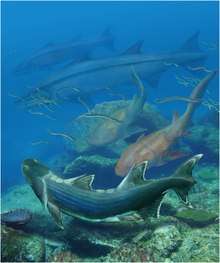
Etymology
The generic name translates as "complete jaw", referring to how the animal had a complete set of dermal marginal jaw bones. The specific name translates as "primordial".
Evolutionary significance
Prior to the discovery of Entelognathus, scientists assumed that the last common ancestor of jawed vertebrates was a shark-like animal, with no distinct jawbones, and that modern jaws evolved in early bony fishes. This discovery shows that modern jaws evolved earlier. It is possible that Chondrichthyes started with distinct jaws and then dispensed with them. This has been called the earliest known animal with what looks like a face.[2][3]
References
- Zhu, Min; Yu, Xiaobo; Ahlberg, Per Erik; Choo, Brian; Lu, Jing; Qiao, Tuo; Qu, Qingming; Zhao, Wenjin; Jia, Liantao; Blom, Henning; Zhu, You’an (2013). "A Silurian placoderm with osteichthyan-like marginal jaw bones]". Nature. 502 (7470): 188–193. doi:10.1038/nature12617. ISSN 0028-0836. PMID 24067611.
- Barford, Eliot (25 September 2013). "Ancient fish face shows roots of modern jaw". Nature. doi:10.1038/nature.2013.13823. Retrieved 26 September 2013.
- Friedman, Matt; Martin D. Brazeau (2013). "News & Views: Palaeontology: A jaw-dropping fossil fish". Nature. 502: 175–177. doi:10.1038/nature12690.
External links
- National Geographic - Fish fossil has oldest known face, may influence evolution
- Reuters - Fossil fish find in China fills in evolutionary picture
- Discover Magazine - First jawed fish had one ugly face
- Scientist hails 'jaw-dropping' fish fossil discovery (BBC, 2013-09-27)
